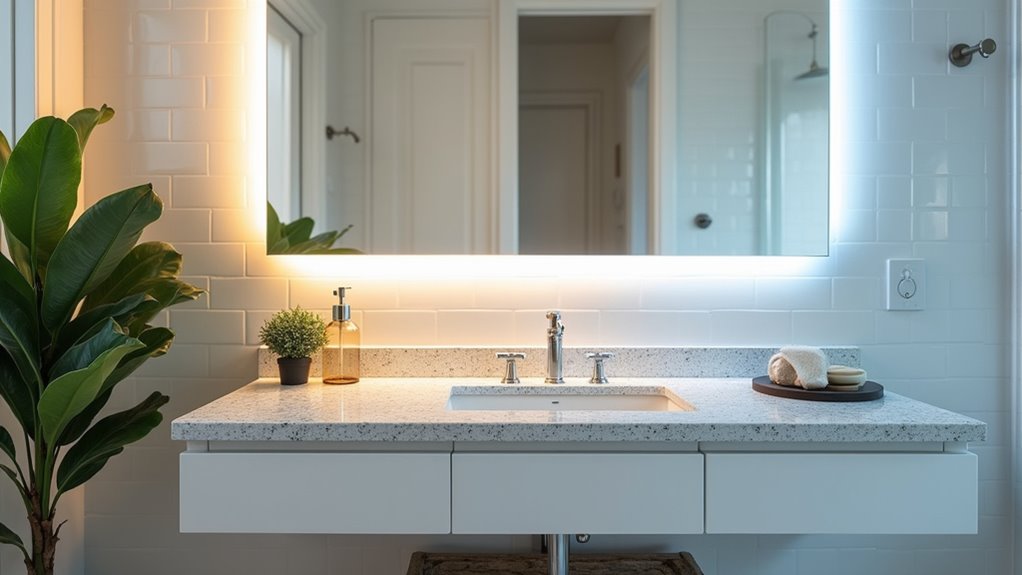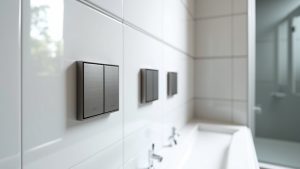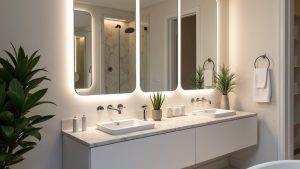Choosing the right Kelvin temperature for bathroom lighting is crucial for functionality and ambiance. Generally, 3000K to 4000K is ideal for general lighting, while 4000K to 5000K works best in vanity areas, mimicking natural daylight. For relaxation zones like showers, warmer tones (2700K to 3000K) are preferred. High Color Rendering Index (CRI) values ensure accurate color perception, enhancing the space’s appeal. Taking these factors into account can significantly improve a bathroom’s design and usability. More insights await.
Key Takeaways
- For general lighting, choose 3000K to 4000K for balanced illumination; 2700K to 3000K for a cozy atmosphere.
- Use 4000K to 5000K for vanity lighting to mimic natural daylight; 3000K to 4000K for flattering light.
- Opt for 2700K to 3000K in shower areas for relaxation, or up to 4000K for better visibility.
- Accent lighting around 2700K adds warmth, while 4000K gives a modern and crisp appearance.
- High CRI (90+) is essential for accurate color rendering, enhancing textures and finishes in the bathroom.
Understanding Kelvin Temperature and Its Impact on Lighting

Kelvin temperature plays a crucial role in defining the quality and characteristics of lighting. The scale measures color temperature, influencing the perceived warmth or coolness of light. Lower Kelvin values, typically ranging from 2000K to 3000K, produce inviting, yellowish hues reminiscent of candlelight, enhancing coziness in a space. In contrast, higher values, between 5000K and 6500K, emulate daylight with cooler, bluish tones, stimulating alertness. Mid-range values, around 3100K to 4500K, provide neutral white light suitable for various tasks. Understanding these color temperature variations is key to creating an ambiance that aligns with emotional and functional needs. Choosing the appropriate Kelvin setting directly affects light warmth, mood, and productivity in any given environment, and it is essential to consider the Correlated Color Temperature(CCT) represented in Kelvins for effective lighting selection. Additionally, an understanding of colour temperature directly affects circadian rhythms and sleep-wake cycles, as warm light promotes relaxation while cooler light enhances focus.
Ideal Kelvin Ranges for Different Bathroom Zones

When selecting the ideal Kelvin range for various bathroom zones, it is essential to consider the specific functions and atmospheres each area requires. The right lighting enhances safety, comfort, and aesthetics.
- General/Ambient Lighting: 3000K to 4000K provides balanced overall illumination, while 2700K to 3000K creates a cozy atmosphere. High CRI halogen bulbs ensure vivid, true colors, which can be important in these settings.
- Vanity/Mirror Task Lighting: 4000K to 5000K mimics natural daylight for grooming, though 3000K-4000K offers a flattering light.
- Shower and Bathtub Lighting: 2700K to 3000K promotes relaxation, with up to 4000K for clarity when necessary.
- Accent and Decorative Lighting: Ranges from 2700K for warmth to 4000K for a modern, crisp effect.
For those looking to maximize the functionality of their bathroom lighting, consider integrating versatile rotatable design options into your setup. Ultimately, selecting appropriate Kelvin values enhances both functionality and ambiance in the bathroom.
The Importance of Color Rendering Index (CRI)

Color accuracy plays a pivotal role in the effectiveness of bathroom lighting, where the Color Rendering Index (CRI) becomes an essential consideration. Measuring from 0 to 100, CRI assesses how accurately a light source reveals the true colors of objects.
High CRI values (90 or above) ensure that tasks such as applying makeup or coordinating outfits are performed with optimal color perception, making skin tones appear natural and healthy. Conversely, lower CRI values can distort colors, leading to misjudgments.
Proper CRI accuracy not only enhances the visibility of textures and finishes but also contributes to a vibrant, inviting atmosphere in the bathroom. Thus, prioritizing high CRI lighting is vital for achieving visually pleasing and functional spaces.
Common Mistakes in Bathroom Lighting Choices

While selecting bathroom lighting, many individuals frequently overlook critical factors that contribute to an effective and functional design.
Common mistakes often include:
- Incorrect Fixture Placement: Relying solely on overhead lights causes harsh shadows, while side-mounted fixtures offer balanced illumination around mirrors.
- Inadequate Lighting Levels & Types: A single light source fails to provide necessary layered lighting, compromising both safety and user experience.
- Disregarding Safety Considerations: Using fixtures without appropriate IP ratings can create hazards in high-moisture areas, risking electrical safety. It is essential to adhere to local building codes, especially regarding clearances from water sources, to ensure safety.
- Neglecting Functionality Enhancements: Omitting dimmable options limits control over ambiance and can hinder practical tasks, such as grooming.
When wiring a bathroom fan and light switch, it’s important to ensure compliance with local electrical codes to enhance safety and functionality. Addressing these oversights ensures a well-lit, safe, and functional bathroom environment.
Tips for Creating a Versatile Lighting Design in Your Bathroom

Creating a versatile lighting design in the bathroom is integral to overcoming common pitfalls identified in previous selection processes. A successful approach combines ambient, task, and accent lighting elements.
Ambient lighting lays the groundwork with fixtures such as flush mounts or recessed lights, ensuring safe navigation and overall brightness. Task lighting is crucial for specific activities; placing vanity lights at eye level minimizes shadows during grooming tasks.
Finally, accent lighting enriches the aesthetic by highlighting architectural features and decor. Strategic fixture placement enhances functionality and mood, transforming the space from an energizing morning routine to a tranquil evening retreat.
Incorporating dimmers further allows for tailored brightness adjustments, maximizing the utility and ambiance of bathroom lighting.




